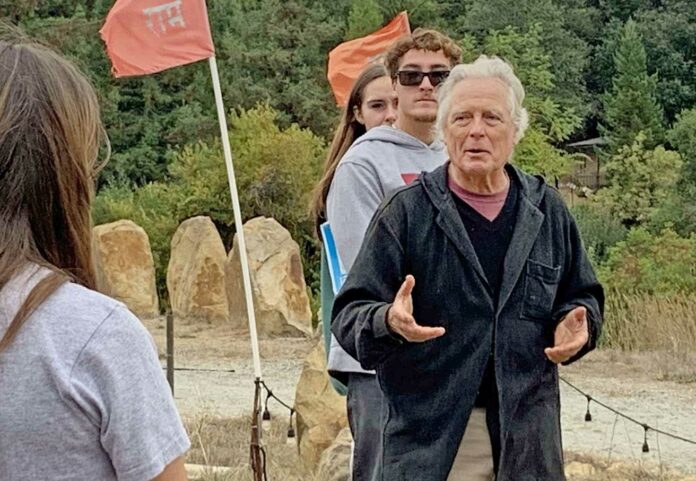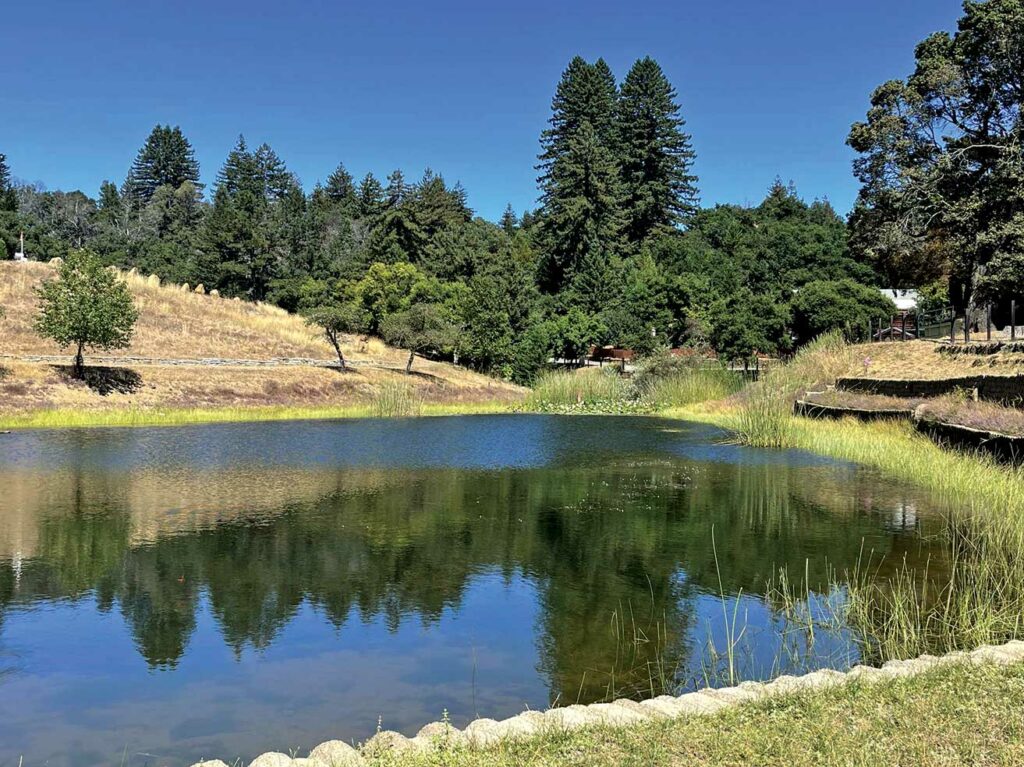
On a recent afternoon, wind-blown cumulus clouds filled the sky and sunlight permeated towering redwood trees and grassland meadows, reflecting off the water of a small lake on the Mount Madonna School (MMS) campus in the mountains above Gilroy. As senior students navigated a short hillside trail from their classroom down to the lake, they chatted and took in an expansive view of Monterey Bay.
The students were accompanied by their teacher, Sara Sobkoviak, and guest Sukhdev Pettengill, a former Mount Madonna Center (MMC) resident, whom the students had invited to talk with them about the lake’s origins and water quality testing, in preparation for new water quality testing they will initiate.
The field meeting was part of a year-long class effort—the Senior Capstone Project—with students committed to revitalizing and enhancing the lake ecosystem with native flora and fauna; developing an educational component to share with other students; lakeside signage; birdhouses and “forest mailboxes.”
“We chose this project mostly because we really like the lake,” student Logan Shaw said. “For most of us, it’s pretty nostalgic and we want to keep it preserved for future generations of students and the community to enjoy it, just as we have enjoyed it growing up.”
Student Beatrice Miller, the assistant project manager, asked Pettengill if there are water quality concerns as regards to wildlife—including the abundant deer and turkeys—drinking from the lake’s waters. While all warm-blooded animals carry E. coli bacteria, Pettengill told them it isn’t a huge concern as the water isn’t potable.
He suggested that any testing should include checking for bacteria, for informational purposes, as well as looking for nitrates, which are harmful to humans. Nitrate toxicity is a concern in communities where there is extensive chemical use or agricultural runoff, but neither of these impact the Mount Madonna lake.
In previous years, MMS high school seniors have created and presented individual capstone projects. This year, Sobkoviak proposed the idea of a single group effort to be selected by the students. Students chose from several ideas submitted by school faculty, staff and the MMC community, and unanimously selected to work on helping to revitalize the lake ecosystem.
“The seniors’ efforts will be centered around helping to build the lake ecosystem so there is more abundance and diversity in wildlife and native plants,” Sobkoviak said. “They want to bring more of an intentional focus on nature to our own campus mountaintop, and have a more welcoming space for the community and visitors.”
Once their project focus was selected, students self-organized by writing their own “job titles” and descriptions, making agreements and norms as a framework for each class, and even incorporated a project management tool, Notion, to help them stay informed on timelines, communications and project processes. They also drafted a mission statement, a list of objectives and identified the stakeholders who will be impacted by the project.
Students will partner with outside organizations such as Watsonville Wetlands Watch (which they visited on Nov. 13) to learn about the area’s native species, and receive advice on the steps to attracting more wildlife, in general, and birds, specifically.

Their project scope includes reducing the populations of some of the non-native invasive species such as bullfrogs and the waterweed, elodea. The elodea, frequently used in home fish tanks and aquariums, may have originally been introduced to the lake by someone emptying a home set up years ago—along with non-native goldfish, which through the years have multiplied.
“I’m interested in the water safety aspects of the project and helping to clear the water of elodea,” said 12th-grader Wyatt Adams. “At the least, we want to reduce the amount of elodea present, as it does affect the overall water quality. We’ve been swimming in the lake since preschool, and we want to help improve it so other people can enjoy it safely, like we have.”
Elodea removal got underway a few weeks ago, with an MMC resident operating an aquatic “harvester” on the lake, its mechanical “jaws” grabbing large swaths of the waterweed from open sections of the lake and piling it on the shore, to later be composted.
Next spring, the senior students will hop in the water and complete a manual removal of additional elodea that is growing around a protected lotus garden at one end of the lake.
The students have dubbed their effort The Lotus Project, in recognition of a healthy grove of Nelumbo nucifera lotus, which are a distinct and visible feature along the lake’s northeast shore.
Student Sophia Manzur is the project’s social media manager and Cy Harris is the lead designer. Harris designed a colorful lotus blossom logo to help brand the project, while Manzur curated a color palette based on the design to use for social media posts tied to the logo.
“It’s their vision from start to finish,” Sobkoviak said. “Many students in this class have a long association with the school, campus and lake, and feel strongly about taking on this restoration effort. I also have a special interest in regenerative agriculture and this opportunity to reestablish native plants and animals into this campus lake ecosystem is especially meaningful. My own role with this will be very much as an advisor—the effort and work will be student-led and student-driven.”
At capacity, the lake can hold some five-and-a-half to six acre-feet—roughly one-and-a-half million to two million gallons—of water. It is located on a 380-acre property shared by the school, MMC residents and the Mount Madonna Institute, a classical yoga school and Ayurvedic college.















It’s pretty amazing how young people can get involved in real, hands-on projects like revitalizing a lake ecosystem — it actually reminds me of the practical approach I got to experience myself at the medicine summer school oxford. It wasn’t just textbooks and lectures — we had discussions with real professionals, group projects, and even lab practice that made everything click. I’ve always believed that learning works best when you can connect theory to the real world, and this programme definitely did that for me. If anyone’s thinking about exploring medicine seriously, that kind of environment is a total game-changer.